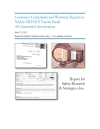Last week, NHTSA pitched its two technical tomes on Toyota unintended acceleration at a pack of reporters, declared that the automaker’s electronics were fine, and ran away. Our esteemed Secretary of Transportation Ray LaHood then made the media rounds, grousing that the critics hadn’t read the report, which leads us to ask: Did Ray?
We’ve been reading it and re-reading it, and conferring with a wide range of technical experts – some of whom have extensive experience in engine management control design, validation and testing. And we gotta tell you, Ray, we aren’t ready to buy our kid a new Toyota.
Far from exonerating Toyota electronics, the reports by NHTSA and the NASA Engineering and Safety Center (NESC) confirm the paucity of the automaker’s safety diagnostics. The NESC team also identifies how the two signals in the accelerator pedal position sensor can be shorted in the real world – leading to an open throttle (aka, tin whiskers). Hell, NESC found the potential in three pedals – that’s a pretty significant percentage in a very small sample. Tin whiskers are such a serious issue that NASA has devoted considerable resources to studying them. They have wreaked electronic havoc on everything from medical devices to weapons systems and satellites. Yet, the NESC report treated the discovery of tin whiskers in a third of their pedal sample like a dead end, instead of a promising avenue of study. Continue reading →
